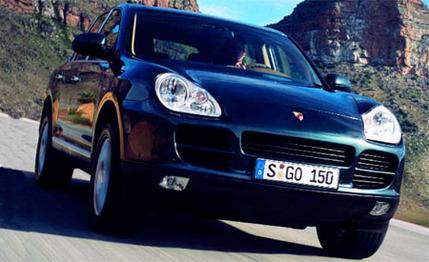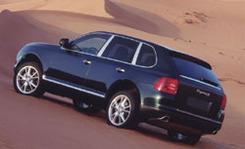
 First Drive Review
First Drive Review
"Who let the dogs out? One of 'em took a crap on the grass."
The voice comes from behind me. There are Australians in the crowd. They're cantankerous. They've been forced to wear a coat and tie when nobody has died.
"Hey, this thing is uglier than a hatful of busted arse'oles."
I don't turn around. Ten hours were whiled away in an Airbus getting to this particular hotel lawn in Leipzig, Germany, 10 more will be consumed by the trip home, and this is the only 15 minutes Porsche has scheduled out of the whole trip to touch and sit in its new Cayenne sport-utility. It's a big deal, and seconds count.
The impressions are quick out of necessity. The $56,665 Cayenne S and the $89,665 Cayenne Turbo each resemble a 911 that was rear-ended by a Country Squire, sliced horizontally from nose to tail, and sectioned upward with about 16 extra inches of sheetmetal. Considering that it wears the Porsche shield, the Cayenne sports a full figure.


Indeed, it is a precious few inches wider and longer than a BMW X5 but actually feels a tighter fit inside. The leather front buckets are intimate; the leather rear bench is a squeeze. Some extra space seems to be hiding in the back: no third row of seats, but a deep cargo area. The five clustered dials are a super-size variation of the 911's instrument panel, and leather terror grips bracket the shifter for the six-speed automatic transmission. A six-speed manual, maybe, comes to the U.S. next year, says Porsche spokesman Jay Allison.
A diesel? A V-6 version? All rumors.
Porsche employees suddenly hop into the Cayennes and drive away. The crowd murmurs its frustration. "Well, fist it," says an Aussie voice, whatever that means.
Regardless of how you feel about Porsche giving up sports-prototype racing for four years to develop a two-and-a-half-ton luxury sport-utility, the Cayenne is guaranteed its place in the company's annals. The Cayenne is Porsche's first truck, its first vehicle of any kind with five doors, and its first product since 1950 to be built in a Porsche-owned factory that isn't in Zuffenhausen.
Porsche's sport-utility. It's like saying Piaget's pencil sharpener. Some words simply don't belong in the same brochure. But if you stack every air-cooled 911 ever built, three Porsche 917s, the pit clock at Le Mans, and James Dean's string-backs on one side of a philosophical scale, Porsche CEO Wendelin Wiedeking believes you can easily tip it in the Cayenne's favor with this one assumption:
"For Porsche to remain independent, it can't be dependent on the most fickle segment in the market," he says. That's a reference to two-seat sports cars, pricey baubles with sales that generally crater in conjunction with the economy, as they did in 1991-93 when Porsche sales collapsed.
"We don't want to become just a marketing department of some giant," Wiedeking continues. "We have to make sure we're profitable enough to pay for future development ourselves."
Wiedeking isn't a sentimentalist. In fact, he's a pit bull dressed in a pinstripe suit. He recently shelved plans to list Porsche AG on the New York Stock Exchange rather than take the SEC-mandated oath on the company's earnings statements, and he told managers of a German stock index to fist it when they demanded Porsche AG increase the frequency of its earnings statements.
Whatever Porsche needs to do to survive, Wiedeking will likely do it. Hence, the Cayenne. It is not so much a joint venture between Porsche and Volkswagen, which will sell the substantially cheaper Touareg version that it builds in the nearby Slovak Republic, but a handshake agreement between Wiedeking and Ferdinand Piëch, the VW Group's former chairman-in-czar and a major shareholder of Porsche.
Under the deal, struck in 1998, Porsche and Volkswagen jointly set the hard points of the platform, VW engineered details such as the electrical architecture, and each company did its own engines, styling, and chassis tuning. VW supplies Porsche's new $124 million glass-walled Cayenne assembly plant in Leipzig with painted bodies, and suppliers ship in about a dozen preassembled modules. Only 20 percent of the Cayenne, mainly the new 335-hp, 4.5-liter DOHC V-8 and its 444-hp twin-turbo variant, is in fact built by Porsche.
Klaus-Gerhard Wolpert, the Cayenne's project leader, promises the Cayenne "will show what a sport-utility is capable of."
The 5200-pound Turbo model should hit 62 mph in 5.6 seconds; the 4950-pound S in 7.2 seconds. Axle weights are split nearly 50/50, and each will be able to tow 7700 pounds. The full-time four-wheel drive has an open center differential and splits the torque 38/62 percent front to rear. Unlike most of its competitors, the Cayenne has a 2.7:1 low-range ratio for rock crawling and an optional locking rear differential. Six-piston-front and four-piston-rear calipers on huge (13.8 inch front, 13.0 inch rear) rotors do the stopping.
Porsche knows many of the purists, especially in the U.S. where 60 percent of the 25,000-unit annual build is headed, won't forgive the company for the Cayenne no matter how sweetly it drives. We might, but not until we get more than 15 minutes with it.